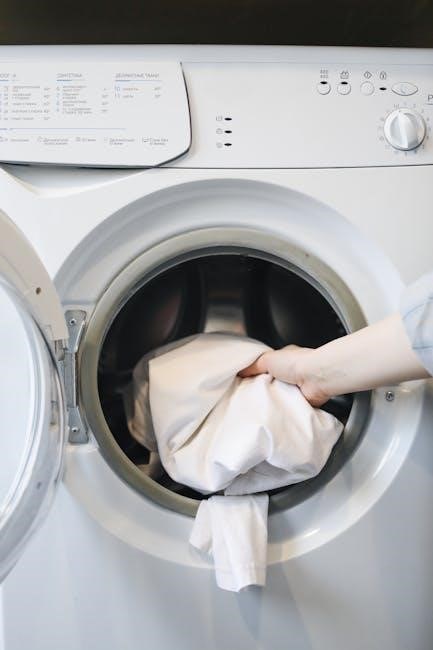Honeywell TH5220D1003 Manual: A Comprehensive Guide

This comprehensive guide serves as your one-stop resource for understanding and utilizing the Honeywell TH5220D1003 thermostat. It simplifies operation‚ offering clear instructions and troubleshooting tips. Whether you are a new user or seeking advanced functionalities‚ this guide provides the necessary information.
The Honeywell TH5220D1003 is a FocusPRO non-programmable digital thermostat designed for electronic control of 24 Vac conventional and heat pump systems‚ as well as 750 mV heating systems. It provides precise comfort control‚ maintaining consistent temperatures with a high level of accuracy‚ typically within +/- 1°F.
This thermostat is known for its ease of use and reliability‚ making it a popular choice for homeowners seeking simple and effective temperature management. The TH5220D1003 features a clear digital display‚ offering either a large screen or standard size option‚ ensuring easy readability. A user-friendly interface allows straightforward adjustments to temperature settings.
One of the key highlights is the easy-change battery door‚ which allows for simple battery replacement without requiring removal or disassembly of the thermostat. This feature enhances convenience and minimizes disruption during maintenance. Furthermore‚ the Honeywell TH5220D1003 comes with a 5-year limited warranty‚ providing assurance and support for long-term use. This thermostat is pre-programmed by the installer.
Key Features of the TH5220D1003
The Honeywell TH5220D1003 thermostat boasts several features designed for user convenience and efficient temperature control. Firstly‚ its non-programmable nature simplifies operation‚ making it ideal for users who prefer manual adjustments over complex scheduling. The thermostat offers precise comfort control‚ maintaining consistent temperatures with minimal deviation.
Display options include both large screen and standard size‚ ensuring readability for users with varying visual preferences. The easy-change battery door allows for quick and hassle-free battery replacement without dismounting the unit. This eliminates the need for tools or complicated procedures‚ saving time and effort.
The TH5220D1003 is compatible with a range of systems‚ including 24 Vac conventional and heat pump systems‚ as well as 750 mV heating systems‚ providing versatility for different home setups. Its electronic control ensures accurate and reliable performance‚ while the 5-year limited warranty offers added peace of mind. Designed for straightforward use‚ the TH5220D1003 ensures a comfortable and energy-efficient home environment. This model is ready to go‚ and it is also pre-programmed by the installer.
Installation and Wiring Instructions
Prior to commencing the installation of the Honeywell TH5220D1003‚ it is crucial to disconnect the power supply to prevent any electrical hazards. Begin by carefully removing the existing thermostat from its wall plate. Identify and label the existing wires to ensure correct reconnection later.
Next‚ mount the new TH5220D1003 wall plate securely to the wall using the provided screws. Ensure the wall plate is level for accurate thermostat operation. Refer to the wiring diagram to connect the appropriate wires to the corresponding terminals on the wall plate. Double-check all connections to ensure they are secure and properly tightened.
For conventional systems‚ typical wiring includes terminals for heating (W)‚ cooling (Y)‚ fan (G)‚ and power (R and C). Heat pump systems may require additional connections for reversing valve (O/B) and auxiliary heat (AUX/E). Once all wiring is complete‚ carefully attach the TH5220D1003 thermostat to the wall plate. Restore power to the system and verify that the thermostat is functioning correctly. Follow the thermostat function program selection to make sure the thermostat is working correctly. Always consult a qualified technician if you are unsure about any aspect of the installation process.
Wiring Diagram Selection
Selecting the correct wiring diagram is paramount for the proper functioning of your Honeywell TH5220D1003 thermostat. Begin by identifying your heating and cooling system type. Common systems include conventional heating and cooling‚ heat pump systems with or without auxiliary heat‚ and heating-only or cooling-only systems.
Conventional systems typically use a single transformer to power both heating and cooling components. Heat pump systems‚ on the other hand‚ may require a different wiring configuration due to the reversing valve‚ which controls the flow of refrigerant for heating and cooling. Refer to the wiring diagrams provided in the Honeywell TH5220D1003 manual to identify the diagram that matches your system type.
Carefully compare the wire labels from your old thermostat with the terminal designations on the new TH5220D1003 wall plate. Ensure that each wire is connected to the corresponding terminal as indicated in the selected wiring diagram. Incorrect wiring can lead to system malfunction or damage. If you are unsure about the correct wiring diagram for your system‚ consult a qualified HVAC technician for assistance. Confirming the accuracy of the wiring diagram is important for optimal performance and energy efficiency.
Terminal Designations Explained
Understanding the terminal designations on your Honeywell TH5220D1003 thermostat is crucial for correct wiring and system operation. Each terminal corresponds to a specific function within your heating and cooling system. Common terminal designations include Rh‚ Rc‚ W‚ Y‚ G‚ and C.
The Rh terminal typically connects to the heating system’s power supply‚ while the Rc terminal connects to the cooling system’s power supply. In some systems‚ these may be jumpered together if a single transformer is used. The W terminal is for the heating wire‚ which activates the furnace or other heating equipment. The Y terminal is for the cooling wire‚ which activates the air conditioner compressor. The G terminal controls the fan‚ allowing it to run independently of heating or cooling.
The C terminal‚ also known as the common wire‚ provides continuous power to the thermostat‚ enabling features like the display and advanced functions. Not all systems require a C wire‚ but it is often recommended for optimal performance. Consulting the TH5220D1003 manual will provide detailed explanations of each terminal and their specific functions in different system configurations. Correctly identifying and connecting wires to their designated terminals ensures proper thermostat operation and prevents potential damage to your HVAC system.
Power Options and Mounting
The Honeywell TH5220D1003 thermostat offers flexible power options to suit various installation scenarios. It primarily operates using battery power‚ requiring two AA alkaline batteries to function correctly. The easy-change battery door allows for simple replacement without disassembling the thermostat‚ ensuring continuous operation. Some installations may also support hardwired power‚ providing a more permanent power source and eliminating the need for battery replacements.
Mounting the TH5220D1003 is straightforward‚ designed for easy installation on a standard wall. The thermostat comes with a wallplate that should be securely attached to the wall using screws. Ensure the mounting location is free from drafts or direct sunlight‚ which can affect temperature readings. Leveling the wallplate is essential for aesthetic appeal and accurate operation.
Once the wallplate is mounted‚ the thermostat easily snaps onto it‚ creating a secure and flush fit. Before mounting‚ carefully consider the wiring connections required for your system and ensure they are properly connected to the corresponding terminals. The combination of battery or hardwired power options and a user-friendly mounting system makes the TH5220D1003 a versatile choice for various home environments. Always consult the installation manual for detailed instructions and safety precautions.
Thermostat Function Program Selection
The Honeywell TH5220D1003 thermostat offers a range of function program settings‚ allowing users to customize its operation to match their specific heating and cooling system requirements. These settings are typically configured during the initial installation process by a qualified technician. Accessing the function program selection mode involves pressing and holding specific buttons on the thermostat until the display changes‚ indicating entry into the setup mode.
Within the function program selection‚ users can adjust parameters such as system type‚ fan control‚ and cycle rates for both heating and cooling stages. The system type setting allows the thermostat to be configured for conventional heating and cooling systems‚ heat pumps‚ or even 750 mV heating systems. Fan control options determine whether the fan operates continuously or only during heating and cooling cycles.
Cycle rates‚ measured in cycles per hour (CPH)‚ affect the thermostat’s responsiveness and temperature accuracy. Different settings cater to various system types‚ ensuring optimal performance and comfort. Selecting the correct function program settings is crucial for efficient operation and preventing potential issues. Refer to the thermostat’s manual for a detailed explanation of each setting and its impact on system performance. Incorrect settings may lead to inefficient energy use or inconsistent temperature control.
Typical Thermostat Function Program Settings

The Honeywell TH5220D1003 thermostat comes with several configurable function program settings that determine how it interacts with your heating and cooling system. Understanding these settings is crucial for optimizing performance and ensuring comfort. A common setting is the system type‚ which dictates whether the thermostat controls a conventional furnace‚ a heat pump‚ or another type of heating system. The typical setting is often “conventional” for standard furnaces.
Another important setting is the fan control‚ which determines if the fan runs continuously or only during heating or cooling cycles. A typical setting might be “auto‚” where the fan runs only when the system is actively heating or cooling; Cycle rates‚ measured in cycles per hour (CPH)‚ affect how frequently the thermostat turns the heating or cooling system on and off. A typical setting for heat cycle rate might be 5 CPH for gas furnaces‚ providing a balance between temperature consistency and energy efficiency.
For two-stage heating systems‚ a second stage heat cycle rate setting is available. Cooling functions also have configurable settings related to temperature display‚ allowing users to choose between Fahrenheit and Celsius. These typical settings are pre-programmed for immediate use‚ but users should always review and adjust them according to their specific system requirements and preferences to achieve optimal comfort and efficiency.
Programming Mode Instructions

The Honeywell TH5220D1003 is a non-programmable thermostat‚ meaning it does not support setting up custom heating and cooling schedules. However‚ it does offer a setup mode for configuring various system settings. To enter the setup mode‚ begin by pressing and holding the “System” and “Fan” buttons simultaneously until the display changes.
Once in setup mode‚ you can navigate through the available options using the up and down arrow buttons. These options include system type‚ fan operation‚ and cycle rates. Select the option you want to adjust and use the arrow buttons to change the value. After making your adjustments‚ press the “System” button to save the setting and move to the next option.
Continue adjusting settings as needed‚ pressing “System” to save each change. Once you have configured all desired settings‚ simply wait‚ and the thermostat will automatically exit the setup mode and return to normal operation. Remember to consult the thermostat’s manual for detailed explanations of each setting and recommended values for your specific heating and cooling system. Although it lacks traditional programming‚ this setup mode allows for customization to optimize performance.
Resetting Your Honeywell TH5220D1003
Resetting your Honeywell TH5220D1003 thermostat can resolve various issues‚ such as display problems or incorrect temperature readings. Although this model isn’t programmable and lacks a traditional reset button‚ there are alternative methods to restore it to a default state or troubleshoot problems.
The simplest approach is to remove the batteries. Open the battery compartment‚ usually located on the front or side of the thermostat. Take out both batteries and wait for approximately one minute. This power interruption often clears any temporary glitches or incorrect settings stored in the thermostat’s memory. Reinsert the batteries‚ ensuring they are correctly aligned according to the polarity markings.
If removing the batteries doesn’t solve the problem‚ check the wiring connections. Ensure all wires are securely connected to their respective terminals. Loose or corroded connections can cause malfunctions. If the issue persists‚ consult the Honeywell TH5220D1003 manual or contact a qualified HVAC technician for further assistance. They can diagnose more complex problems and provide professional solutions‚ ensuring your thermostat functions correctly. Remember to always disconnect power before attempting any wiring adjustments to avoid electrical hazards.
Troubleshooting Common Issues
The Honeywell TH5220D1003 thermostat‚ while reliable‚ can sometimes encounter common issues. A frequent problem is a blank or unresponsive display. First‚ check the batteries. Ensure they are fresh and properly installed. If the display remains blank after replacing the batteries‚ inspect the wiring connections. Loose or corroded wires can disrupt the power supply to the thermostat.
Another common issue involves inaccurate temperature readings. Verify that the thermostat is mounted away from direct sunlight‚ drafts‚ or other heat sources that could skew the readings. If the location is appropriate‚ try resetting the thermostat by removing the batteries for a minute and then reinserting them.

If the thermostat fails to control the heating or cooling system‚ double-check the wiring connections to the HVAC unit. Ensure they match the wiring diagram in the manual. Also‚ verify that the system switch is set to the correct mode (heat‚ cool‚ or off). For persistent problems‚ consult a qualified HVAC technician. They can diagnose more complex issues‚ such as a faulty sensor or a malfunctioning control board‚ and provide the necessary repairs or replacements to restore your thermostat to proper working order.
Warranty Information and Support
The Honeywell TH5220D1003 thermostat typically comes with a limited warranty from Resideo‚ the manufacturer of Honeywell Home products. This warranty generally covers defects in materials and workmanship for a specified period‚ often five years from the date of purchase. To ensure your warranty remains valid‚ it’s crucial to retain your proof of purchase‚ such as a receipt or invoice.
In the event of a defect covered by the warranty‚ Resideo will typically repair or replace the thermostat at their discretion. The warranty usually does not cover damages resulting from improper installation‚ misuse‚ or unauthorized repairs.
For warranty claims or technical support‚ it is recommended to contact Resideo directly. Their customer support team can provide guidance on troubleshooting‚ warranty procedures‚ and authorized service centers. You can find contact information on the Resideo website or in the product documentation included with the thermostat. Additionally‚ numerous online resources‚ such as user forums and FAQs‚ can offer helpful tips and solutions for common issues. Always refer to the official Resideo documentation and support channels for the most accurate and up-to-date information regarding your Honeywell TH5220D1003 thermostat.
